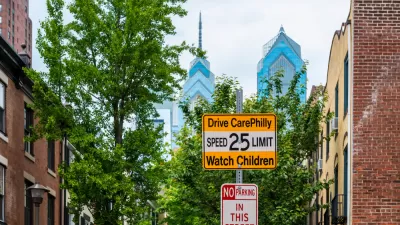Speed limits are currently determined by a calculation that considers only the status quo of vehicular velocity. Standard practices for speed limit setting and legislators should prioritize the safety of community members, according to this article.

Tiffany Chu, founder of transportation company Remix, asserts that American we need to rethink the way we set speed limits in the United States. While transportation laymen may hope that speed limits are set by a calculation determining the safest rules for traveling by car in a given space, the reality it that safety considerations are simply not a part of the calculation. Instead, says Chu, speed limits are set "by the speed at or below which 85 percent of the motorists drive on a given road, an outdated guideline promoted by the Federal Highway Administration (FHWA)."
Chu reminds that speeding has played a part in about a third of traffic collision fatalities in the United States over the past two decades and that, given these statistics, government agencies need to revise the methods for setting speed limits and introduce speed-reducing street design mechanisms on busy roadways.
For Chu, design is at the center of the solution, pointing to a July report released by the National Association of City Transportation Officials (NACTO), which advocates for speed limits set by criteria like density and activity level in addition to designing slow zones. "We cannot usher in a multimodal future without lowering speeds and making streets safe for all users. We must support the work of those undoing harmful legacy methods, and encourage the adoption of policies that embrace and emphasize design," advises Chu.
FULL STORY: Why Slower Commutes Can Be A Good Thing

Alabama: Trump Terminates Settlements for Black Communities Harmed By Raw Sewage
Trump deemed the landmark civil rights agreement “illegal DEI and environmental justice policy.”

Planetizen Federal Action Tracker
A weekly monitor of how Trump’s orders and actions are impacting planners and planning in America.

The 120 Year Old Tiny Home Villages That Sheltered San Francisco’s Earthquake Refugees
More than a century ago, San Francisco mobilized to house thousands of residents displaced by the 1906 earthquake. Could their strategy offer a model for the present?

In Both Crashes and Crime, Public Transportation is Far Safer than Driving
Contrary to popular assumptions, public transportation has far lower crash and crime rates than automobile travel. For safer communities, improve and encourage transit travel.

Report: Zoning Reforms Should Complement Nashville’s Ambitious Transit Plan
Without reform, restrictive zoning codes will limit the impact of the city’s planned transit expansion and could exclude some of the residents who depend on transit the most.

Judge Orders Release of Frozen IRA, IIJA Funding
The decision is a victory for environmental groups who charged that freezing funds for critical infrastructure and disaster response programs caused “real and irreparable harm” to communities.
Urban Design for Planners 1: Software Tools
This six-course series explores essential urban design concepts using open source software and equips planners with the tools they need to participate fully in the urban design process.
Planning for Universal Design
Learn the tools for implementing Universal Design in planning regulations.
Clanton & Associates, Inc.
Jessamine County Fiscal Court
Institute for Housing and Urban Development Studies (IHS)
City of Grandview
Harvard GSD Executive Education
Toledo-Lucas County Plan Commissions
Salt Lake City
NYU Wagner Graduate School of Public Service





























